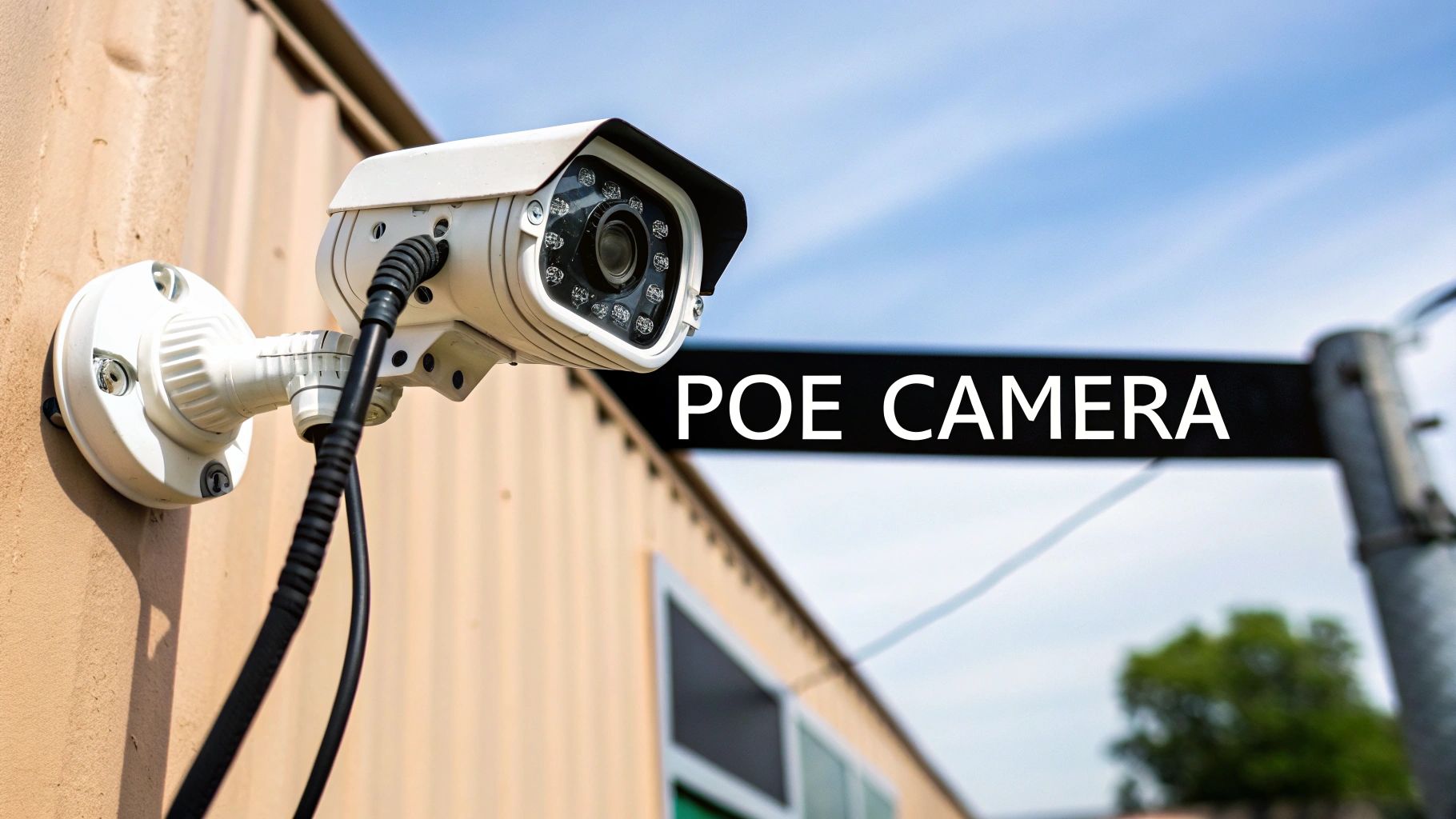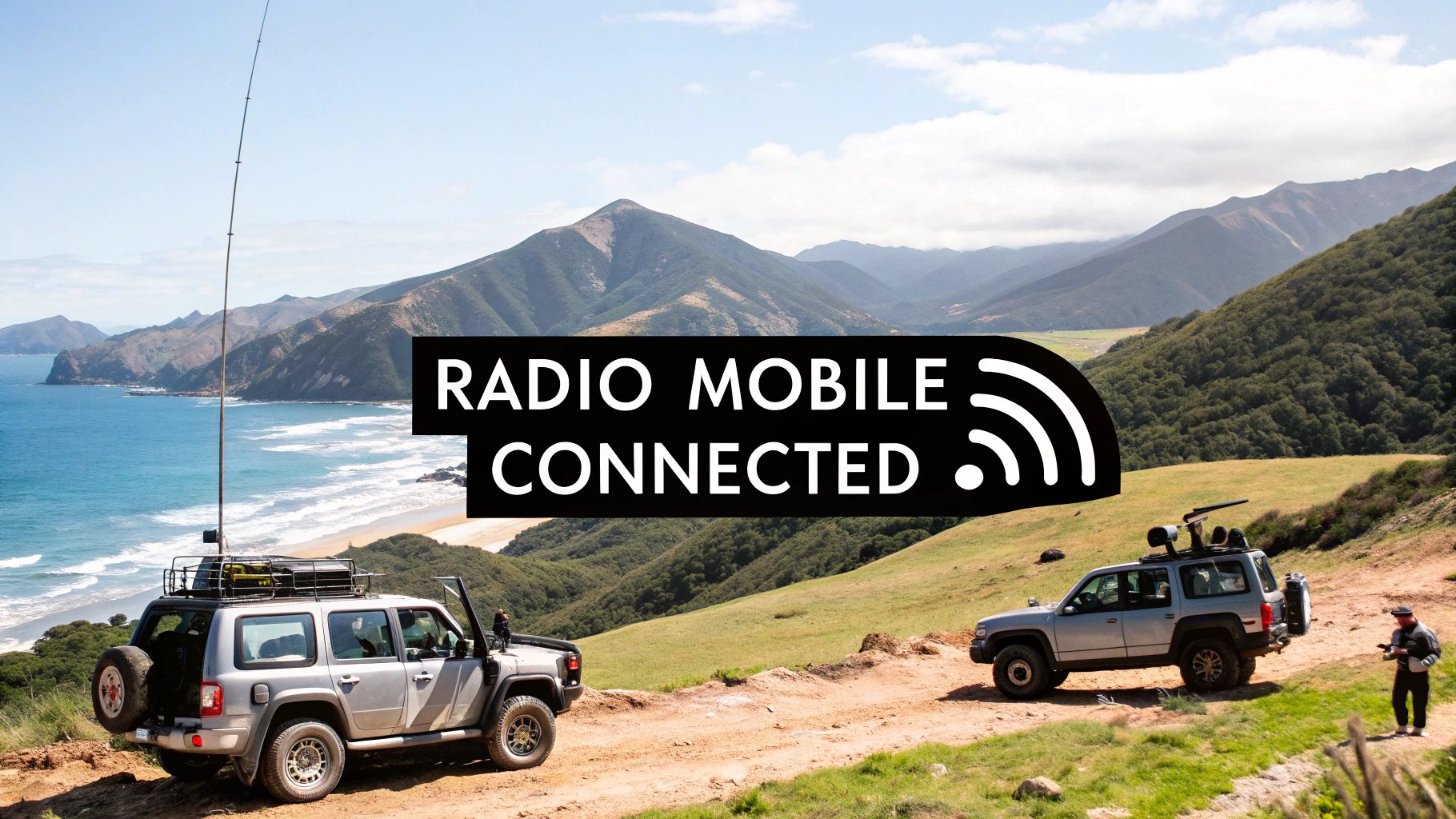Keep Your NZ Team Safe and Productive
In today's New Zealand workplace, staying connected is the critical link that keeps your team safe and your operations running at peak efficiency. For industries where leaner crews and lone workers are the norm, a robust communication strategy isn't just an advantage—it's an absolute necessity for productivity and wellbeing. The importance of strengthening this connectivity between your team and operational systems cannot be overstated; it is fundamental to safety and efficiency, especially as businesses rely on fewer team members to produce the same or greater output.
The Unbreakable Link: Your Business Lifeline
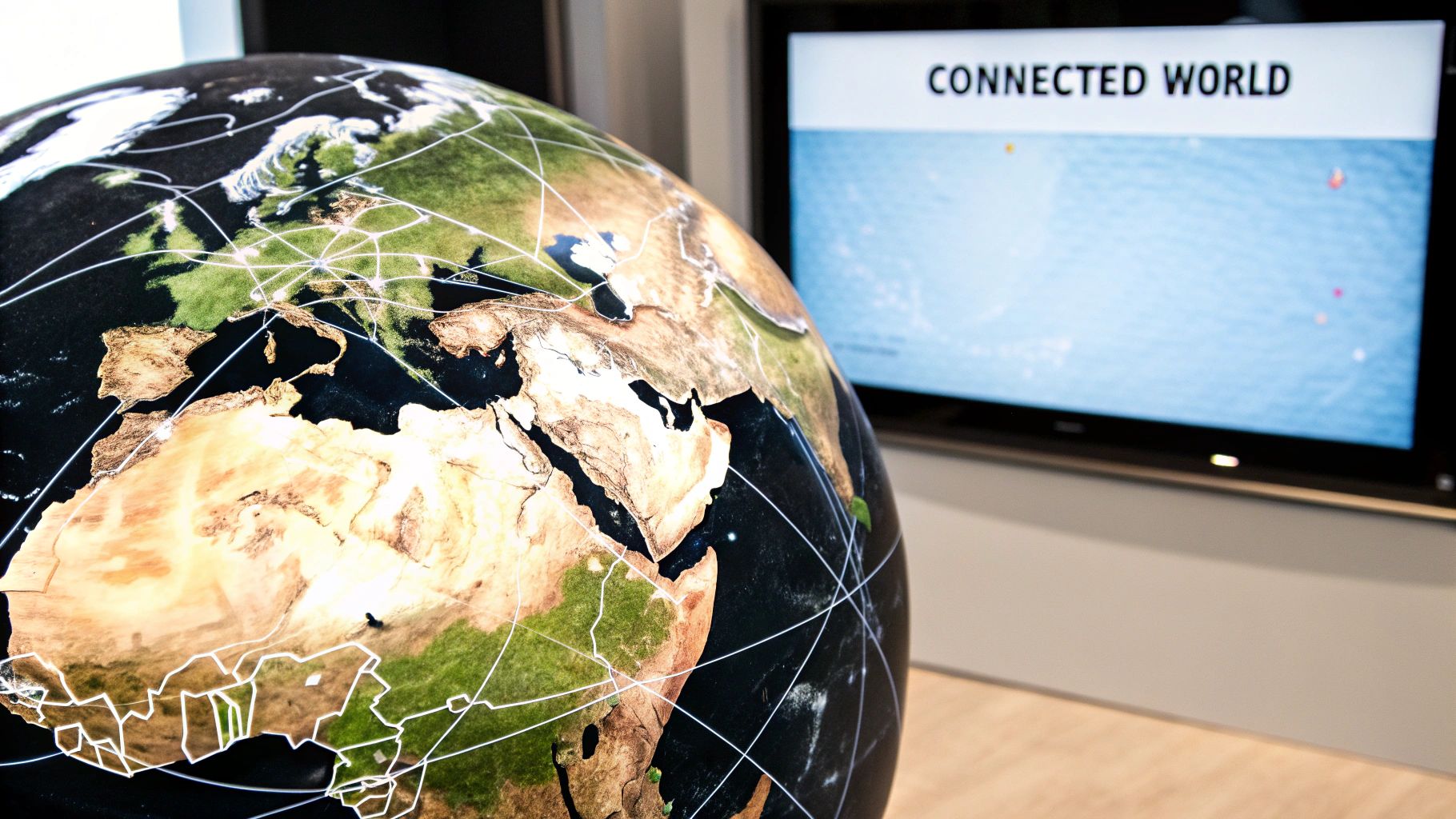
Consider sectors like agriculture, forestry, construction, and logistics here in New Zealand. The pressure is on to achieve more with fewer people. This frequently means individuals are working alone, often in remote or high-risk locations where standard mobile coverage is unreliable or non-existent. Just because a team member is out of sight, they should never be out of reach.
This is where the true value of being properly connected becomes clear. It's about far more than convenience; it's a core component of your health and safety obligations. A strong connectivity plan provides a vital safety net, ensuring every single person can call for help, report an issue, or simply check in, no matter where their job takes them.
Beyond Productivity: A Commitment to Safety
While streamlined operations are a significant benefit, the primary driver for a connected workforce is safety. For your lone workers, the ability to communicate instantly can be a literal lifesaver. A reliable connection means they can report hazards on the spot, request immediate assistance, or receive urgent alerts about sudden weather changes.
You simply cannot overstate the importance of this digital lifeline. It transforms a potentially dangerous situation into a manageable one. Being proactive not only protects your people; it safeguards your business from the significant risks associated with workplace incidents.
The Power of Integrated Systems
Real connectivity is about integrating both voice and data. Think of it this way:
- Voice Communication: This is your immediate, real-time link. A quick call on a two way radio can resolve a problem in seconds or confirm a worker is safe.
- Data Communication: This provides the bigger picture. GPS tracking shows you a vehicle's exact location, digital forms confirm job completion, and system alerts can flag potential issues for managers.
When these two elements work in harmony, they create a powerful and efficient operational system. The importance of this lifeline is fundamental, even when you're taking a well-earned break and need to Keep Connected and in Control on Holiday. Off-the-shelf gadgets from general retailers are simply not built with the specialisation or durability needed for demanding professional environments and often lack the expert support required.
At Mobile Systems Limited, we are experts in seeking improvements in connectivity. We analyse your unique operational challenges and assist in implementing initiatives that strengthen this link, ensuring your team is always safe, productive, and efficient.
Understanding Voice and Data Communication

To keep a modern business connected, it's essential to understand the two core components of communication: voice and data. Each serves a unique purpose, but they work together to keep teams safe and productive, especially across New Zealand's diverse and challenging environments.
Think of them as the twin pillars supporting your entire operation.
Voice communication provides that immediate, real-time handshake between your people. It’s the fastest, most direct way to coordinate a task, issue an urgent warning, or get a quick "all clear" from a lone worker. It is your first line of defence when speed and clarity are paramount.
Data communication, on the other hand, is the detailed report that follows. It adds the rich context that voice alone cannot, fuelling powerful tools like GPS tracking, digital job dispatch, and automated system monitoring. It's the quiet, constant stream of information that keeps the business engine running smoothly.
The Critical Role of Voice Communication
Imagine a forestry worker on a remote site. They spot a hazard and need to alert the machinery operator, now. A sharp, clear voice command from a rugged Motorola or Entel two way radio cuts straight through the noise, preventing a potential disaster. In that moment, a text message or email is dangerously slow.
Voice is absolutely vital for:
- Immediate Safety Alerts: Instantly notifying teams of dangers like machinery faults, sudden weather changes, or medical emergencies.
- Real-Time Coordination: Guiding teams through complex manoeuvres, like reversing a large truck or coordinating a tricky multi-person lift.
- Instant Confirmation: Getting that quick check-in to verify a lone worker is okay and has completed their task in a remote location.
A dedicated voice channel, like a private radio network, ensures your most critical messages get through without fail. That's a level of reliability cellular networks can't always guarantee, especially in remote or congested areas.
The Power of Data in Operations
Now, consider a logistics company with a fleet of vehicles crossing the country. The driver might use their radio for a quick update, but it's the data channel working silently in the background. A GPS tracker constantly sends location updates back to the office, allowing dispatchers to optimise routes, predict delivery times, and keep customers informed.
This is where you see the true power of data. It’s not just about knowing where something is; it’s about building a smarter, more responsive business.
Integrating data allows for:
- Enhanced Situational Awareness: Managers can view every asset and team member on a single map, making it easier to allocate resources where they're needed most.
- Improved Efficiency: Automated data from machinery can trigger a maintenance alert before a breakdown, slashing downtime and avoiding costly repairs.
- Digital Record-Keeping: Workers can send digital forms or photos directly from the field, eliminating paperwork and creating an instant, verifiable record of a completed job.
Bringing Voice and Data Together
The real magic happens when you stop thinking about voice or data and start integrating them seamlessly. It's a system where the machinery operator who receives an urgent voice command is backed up by data from the machine itself, reporting its operational status. The delivery driver’s GPS location data is complemented by their ability to instantly call for help via voice if they encounter a problem.
This unified approach ensures every angle is covered, creating a powerful safety net and a highly efficient operational framework.
By understanding how these two elements support each other, you can build a communication strategy that keeps your people and your business fully connected, no matter the challenges. Here at Mobile Systems Limited, we specialise in analysing these exact needs and putting solutions in place that deliver genuine improvements in business connectivity.
Choosing the Right Network Technology for NZ Terrain
New Zealand's landscape is a beautiful beast. From the dense bush of the central plateau to the rugged coastlines of the South Island, our terrain presents a unique challenge for staying connected. There is no single solution that works everywhere.
A system that's perfect for a team in downtown Auckland might be completely useless on a remote farm or out on the water. To build a communication system you can truly rely on, you must understand the real-world strengths and weaknesses of the different network technologies available.
Think of it like choosing the right vehicle. A sports car is brilliant on the motorway but won't get you far up a muddy 4WD track. Similarly, your standard mobile phone is great in the city but can become a dead weight the moment you lose sight of a cell tower. A one-size-fits-all approach is a recipe for failure for any business with mobile personnel.
The image below illustrates how connected our world is becoming, highlighting why a reliable signal is no longer a luxury—it's a core requirement for safety and productivity.
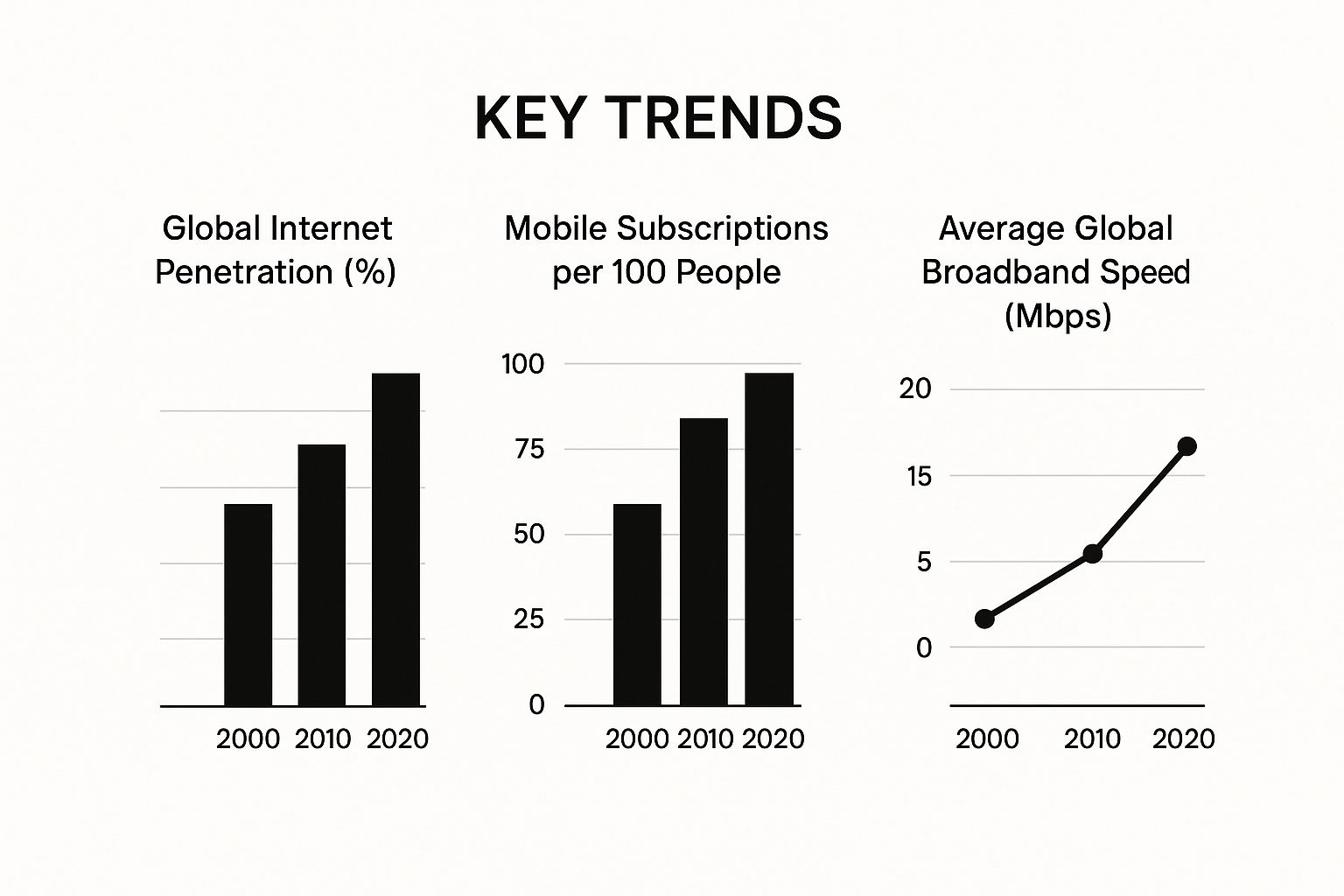
This trend makes it clear: reliable communication isn't just nice to have; it's fundamental to running an efficient and safe operation in any industry today.
To help you navigate the options, let's break down the main technologies and where they excel. We've created a quick comparison table to provide a high-level overview before we dive into the details.
Connectivity Technology Comparison for NZ Businesses
| Technology | Best For | Coverage Area | Key Advantage |
|---|---|---|---|
| Cellular | Urban & suburban operations, logistics, field services | Cities, towns, and major transport corridors | High-speed data and voice on standard devices |
| Private Radio | Mission-critical team coordination in defined areas | Remote sites (forestry, farms, marine) | Unbeatable reliability and instant communication |
| Satellite | Ultimate safety and connectivity in extreme isolation | Virtually anywhere on the planet | The only option when all other networks fail |
This table shows there’s a right tool for every job. Now, let’s explore what that means for your business on the ground.
Cellular Networks: The Urban Standard
For businesses operating primarily in cities and major towns, cellular networks are the default choice. They deliver fast data, clear voice calls, and allow you to use the smartphones and tablets your team is already familiar with. The performance in built-up areas is impressive, making cellular ideal for urban logistics, construction crews, and field service teams.
But here’s the critical limitation: cellular's reach. The moment your team heads into the backcountry, through mountainous passes, or out to sea, that solid connection can vanish. That’s not just an inconvenience; it’s a major safety risk. For these situations, a Cellular booster can sometimes extend coverage, but it's not a complete solution for true remote work.
Private Radio Networks: Unmatched Reliability
This is precisely where private radio networks demonstrate their value. Technologies like Digital Mobile Radio (DMR), VHF, and UHF are the trusted backbone for industries that cannot afford a dropped connection. This includes forestry crews deep in the bush, marine vessels navigating the coast, and large-scale farming operations.
Unlike cellular, a private radio network is your own. You control the infrastructure, so you aren't at the mercy of a public provider’s coverage map. This provides significant advantages:
- Guaranteed Coverage: You can place repeaters to blanket your entire operational area with a strong signal, regardless of remoteness.
- Instant Communication: With push-to-talk, your team can communicate with one person or the entire group instantly. No dialling, no waiting.
- Extreme Durability: Commercial-grade radios from brands like Motorola or Icom are built tough. They are designed to handle water, dust, and drops in ways a smartphone never could.
For localised, mission-critical team coordination and safety, a private radio network offers a level of dependability that cellular cannot match in challenging environments.
Satellite Solutions: The Ultimate Safety Net
But what about when you’re operating far beyond the reach of any land-based network? That’s when satellite technology becomes your lifeline. Devices on networks like Starlink or Iridium provide a connection almost anywhere on the planet.
This makes them an essential safety tool for anyone working or travelling in true isolation.
A Satellite Communicator, like a Personal Locator Beacon (PLB) or an EPIRB for a boat, is a literal lifesaver, able to send an SOS with your GPS location to emergency services. For more routine needs, satellite phones provide voice and basic data, ensuring you can always make a call.
While it comes at a higher cost, having a satellite connection is the final piece of a truly comprehensive communication and safety strategy. To get a better handle on how this tech works in our part of the world, check out our guide to satellite internet in New Zealand.
Ultimately, the smartest approach for most New Zealand businesses is a hybrid one—a clever mix of these technologies. A system designed by specialists ensures your team always has the right tool for the situation, keeping them safe, productive, and connected, no matter where the job takes them.
Essential Gear to Keep Your Team Connected
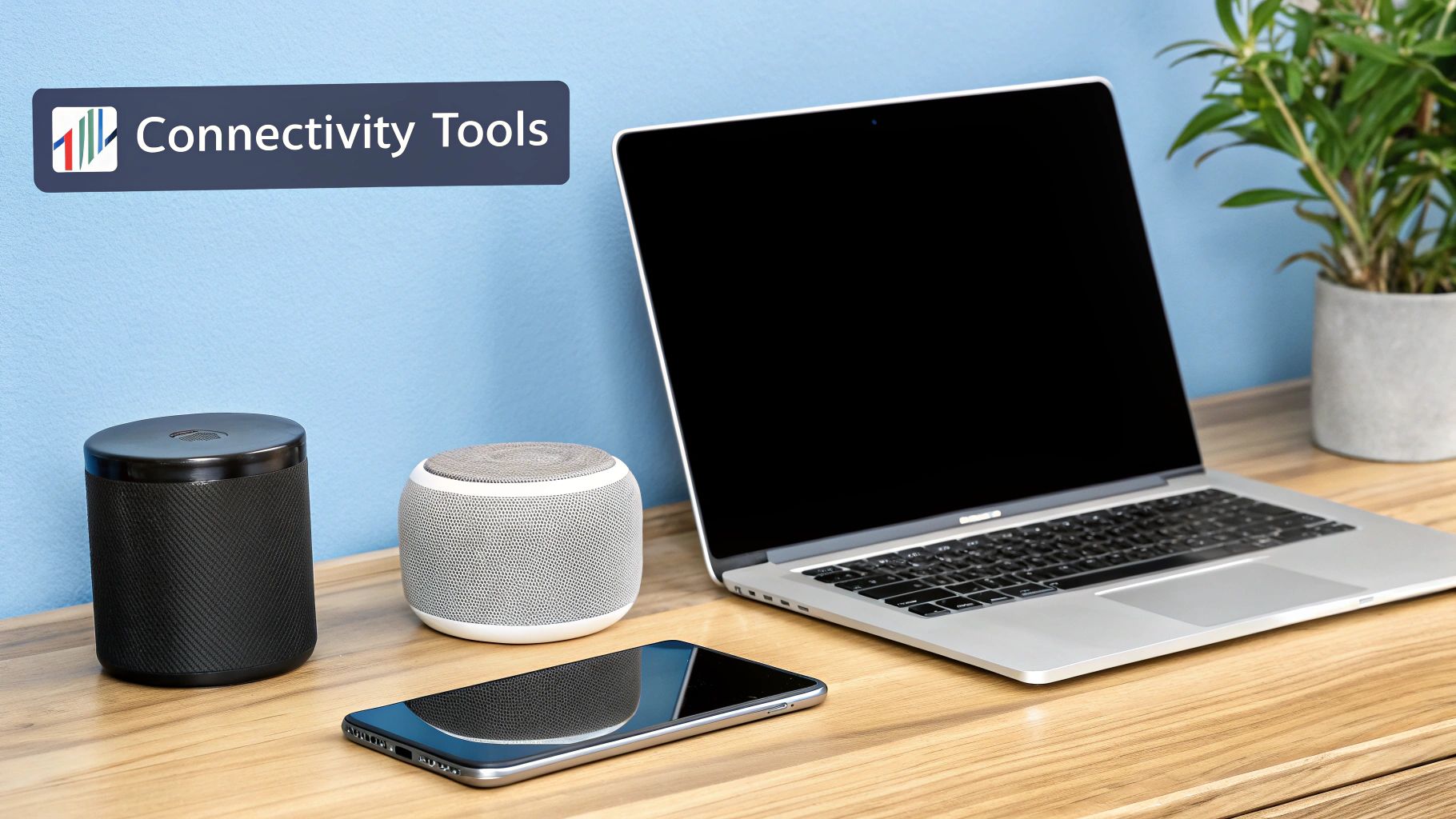
Choosing the right network is only half the battle. The real test of any communication system is the hardware your team actually uses. In New Zealand's demanding work environments, standard consumer electronics are not up to the task. To keep your people truly connected, you need purpose-built, commercial-grade gear designed to survive the realities of the job.
This isn't about finding a fancy gadget; it’s about investing in tools that are as tough and reliable as your crew. Equipment failure isn't just an inconvenience—it's a direct threat to health and safety, productivity, and your entire operation. Sourcing equipment from specialist suppliers who offer deep product knowledge is a non-negotiable part of meeting your obligations and getting the job done right.
Rugged Handheld Two-Way Radios
For instant, clear, and reliable team communication, nothing beats a professional two way radio. These devices are the workhorses for industries from construction and forestry to event management and marine operations. Unlike a mobile phone, they offer one-to-many communication at the push of a button, ensuring everyone gets the message instantly.
Leading brands like Motorola, Entel, Tait, and Hytera have built their reputations on creating radios tough enough for the most demanding environments.
-
Motorola R7: Known for advanced audio that cuts through the loudest background noise and a rugged build that handles drops and shocks with ease.
-
Entel Series: A top choice for their submersible waterproof ratings (IP67 and higher), making them perfect for marine environments or working in heavy New Zealand rain.
-
Tait TP9000 Series: Designed and manufactured in New Zealand, Tait radios are trusted worldwide for their mission-critical reliability, long service life, and flexible multi-mode operation (analogue, DMR, P25). They’re widely used by emergency services, utilities, and large-scale industries where dependable communication is non-negotiable.
-
Hytera HP6/HP7 Series: Compact, lightweight, and feature-rich, Hytera radios are recognised for excellent audio clarity, extended battery life, and smart safety features. They balance durability with affordability, making them popular in transport, civil contracting, and local government operations.
These are serious tools for serious work—built for all-day use in tough conditions. They are a world away from the limited “walkie-talkie” devices found in general stores.
Vehicle-Mounted and Marine Radios
When your team operates from a vehicle, a fixed-mount radio is essential for maintaining a strong, consistent connection. GME is a go-to brand in New Zealand for vehicle comms, offering powerful UHF and CB radios that deliver far superior range compared to handhelds. They're perfect for convoys or agricultural fleets spread across large properties.
For those on the water, the requirements are even stricter. Marine VHF radios are both a legal and practical necessity, providing critical ship-to-shore and ship-to-ship communication. This gear is specifically built for the harsh saltwater environment, ensuring you stay connected to other vessels and coastal stations when it matters most.
Life-Saving Satellite Communicators
When your work takes you completely off the grid—beyond the reach of both cell and radio networks—a satellite communicator becomes your single most critical piece of safety gear. These devices are the ultimate lifeline, providing a connection no matter how remote your location.
Investing in a Personal Locator Beacon (PLB) or an Emergency Position Indicating Radio Beacon (EPIRB) for a boat is a direct investment in your team's safety. In an emergency, a single button press can send an SOS with GPS coordinates to rescue services. It's a feature that can and does save lives.
These devices bridge that final gap in connectivity, ensuring there's never a situation where a worker is completely isolated. For a deeper look at how these tools fit into a wider safety strategy, our guide on the best communication tools for remote teams offers valuable insights.
Essential Features to Look For
When sourcing gear, focus on the features that truly matter for safety and usability. A long-life battery (especially lithium) is critical, ensuring a device can last an entire shift without needing a battery charger. An IP67 rating or higher guarantees the device is both dust-tight and can survive being submerged in water.
Finally, the word rugged should be a key factor in your decision. This means the device has been tested to withstand drops, vibrations, and extreme temperatures. By prioritising this level of quality from a specialist supplier like Mobile Systems, you're equipping your team with the tools they need to stay safe, productive, and reliably connected.
Integrating Systems for Smarter Operations
Real connectivity isn't just about clear calls or a strong data signal. It’s about creating an ecosystem where your communication tools talk directly to your other business systems. This is where you unlock the next level of efficiency, turning standalone devices into a unified platform that makes your whole operation smarter.
Picture this: a GPS tracker on a truck doesn't just show a dot on a map. It automatically updates your logistics software, sends a delivery notification to the customer, and logs the driver’s hours—all without anyone lifting a finger. That's the power of a truly connected business.
This level of integration shifts you from being reactive, dealing with problems after they happen, to being proactive, where live data drives your decisions. The result is increased output, even with a smaller team, by automating tedious tasks and giving managers a complete, real-time picture of field operations.
From Simple Tools to a Powerful Platform
Consider a digital radio (DMR) network. On its own, it’s an excellent tool for team communication. But when integrated, a manager can send a detailed job ticket or a safety alert straight to a worker's handheld radio display. The worker acknowledges the job with a button press, and that confirmation is instantly logged in your management system.
This seamless flow of information defines a smart operation. It eliminates friction, reduces paperwork, and dramatically decreases the chance of human error.
Here's what integration delivers in the real world:
- Automated Workflows: Linking devices like a dashcam or GPS tracker to your software can automate everything from proof of delivery to scheduling vehicle maintenance.
- Better Safety and Compliance: When communication tools are tied into your safety platforms, you get an instant, automatic record of events and check-ins. This simplifies compliance. For businesses serious about safety, exploring specialised WHS Software tailored for New Zealand is a logical next step to unify everything.
- Real-Time Data for Better Decisions: When field data flows directly to your operational dashboard, you can make quicker, smarter decisions on resource allocation.
When you unify your communication channels, you're not just buying equipment; you're building a business intelligence platform. Specialist implementation from an expert like Mobile Systems ensures all the pieces work together seamlessly.
The Foundation of a Connected Future
This push towards smarter, more integrated operations is built on a solid foundation of massive investment in New Zealand’s core infrastructure. Our telecommunications sector is a key part of this connected future, with steady growth shaping the entire industry.
Market analysis shows trends shaping New Zealand's telecom industry on MarketReportAnalytics.com, driven by huge demand for high-speed internet and smart devices. Major projects, like the continued fibre rollout, are boosting network capacity and bringing better broadband to cities and rural communities alike. This development creates the perfect environment for businesses to build more sophisticated, integrated communication systems.
This robust national network provides the backbone, but unlocking its potential for your business requires specialised knowledge. It’s about choosing the right hardware—from a Motorola Radio to a rugged vehicle computer—and ensuring it integrates perfectly with your existing software.
Ultimately, integrating your systems is about making your team safer and your business more productive. It ensures that even with fewer people on the ground, who are more likely to be working alone, your output remains high and your safety standards are never compromised. For any modern New Zealand business, this strategic approach to connectivity is essential.
Future-Proofing Your Business Communications
Investing in a solid connectivity strategy is not just an IT expense—it's a direct investment in your company’s future. It is the critical infrastructure that supports everything from team safety and operational efficiency to long-term growth.
In today's economy, leaner teams are often expected to produce more, frequently while working alone. In that environment, being strategically connected is no longer a choice. It’s absolutely essential for building a resilient and productive organisation.
The journey to becoming a truly future proof business starts with a thorough assessment of your unique operational needs. A one-size-fits-all solution is practically guaranteed to fail. The key is to partner with a specialist who genuinely understands the distinct challenges of the New Zealand landscape and can design a hybrid solution that works for you.
Developing Your Strategic Plan
A future proof strategy doesn't rely on a single piece of technology; it cleverly blends the strengths of different systems. For example, it might mean using the cellular network for your urban fleet, a private radio network for a remote worksite, and satellite communicators as the ultimate safety net for your most isolated lone workers.
To begin developing this plan, consider these steps:
- Assess Communication Gaps: Identify precisely where and when your team currently loses signal. Are these predictable black spots, or are they intermittent failures?
- Analyse Safety Incidents: Review any near misses or incidents where poor communication was a contributing factor. What could have been prevented with a reliable connection?
- Map Operational Needs: Determine what you actually need communication for. Is it instant push-to-talk voice for safety, or data for vehicle tracking and digital job reporting?
This groundwork creates a clear, actionable roadmap for improvement.
The ultimate goal is to architect a communications ecosystem that is as reliable and hardworking as your team. This means moving beyond single-technology solutions and embracing a multi-layered approach that guarantees a connection when it matters most.
Staying Connected in a Digital Nation
Fortunately, New Zealand's digital infrastructure provides a strong foundation to build upon. As a nation, we have incredibly high internet penetration. This widespread access is supported by a robust mobile network and constantly improving broadband speeds, making it easier than ever for businesses to implement sophisticated, connected systems. You can dig deeper into New Zealand's digital connectivity framework on InternetSociety.org.
By taking strategic action now, you can close dangerous communication gaps and build a more efficient, productive, and safely connected organisation. Mobile Systems are experts in assessing these needs and implementing initiatives that prepare your business for whatever the future holds.
Got Questions? We've Got Answers
Navigating the world of commercial-grade communication can seem daunting at first. However, understanding the basics is the first step toward building a safer, more productive operation.
Here are some of the most common questions we hear from New Zealand businesses looking to get their teams properly connected.
How Can We Get Reliable Coverage in Remote Black Spots?
This is a classic problem, and the solution is rarely a single piece of equipment. Tackling a remote black spot usually means taking a hybrid approach and combining technologies to get the job done right.
- Private Radio Networks: If you're working within a specific area, like a farm or a forestry block, a private VHF or UHF radio network is hard to beat. With strategically placed repeaters, you can guarantee solid coverage across your entire site.
- Satellite Communicators: When you have people heading into truly remote areas, a satellite device is the ultimate safety net. An Iridium phone or a PLB provides a lifeline to the outside world, no matter how isolated they are.
- Cellular Boosters: For those frustrating fringe areas with a weak, unreliable signal, a quality cellular booster from a brand like RFI can be a game-changer. It captures that weak signal and amplifies it, making it strong enough for reliable calls and data.
Consumer vs. Commercial Gear: What’s the Difference, Really?
The difference is massive, and it all comes down to safety and reliability. Consumer-grade devices are simply not built for the rigours of a real work environment.
Commercial-grade radios from trusted names like Motorola, GME, or Entel are built tough. We're talking IP67 waterproof ratings, long-life lithium batteries, and rugged shells that can take a beating. More importantly, they operate on licensed radio frequencies, which means your communication is clear and free from interference—a non-negotiable requirement when meeting your health and safety obligations.
What Are the First Steps to Upgrading Our System?
Don't jump straight into buying new equipment. The best place to start is with a proper audit of your current communication gaps. Pinpoint exactly where and when your team loses contact and what the real-world impact is.
Your main goal should be creating a rock-solid link between your people on the ground and your operations back at base. Getting that connection right is fundamental to keeping everyone safe while hitting your productivity targets.
Once you know where the problems lie, it’s time to talk to a specialist. An expert can assess your specific needs—whether it's instant voice for safety alerts or data for GPS tracking—and design a solution that fits. This ensures you invest in a system that truly works for your business, which is especially critical as more teams rely on lone workers out in the field.
At Mobile Systems Limited, our job is to find and fix those connectivity gaps, keeping your team safe and your business running smoothly. Explore our solutions today.

